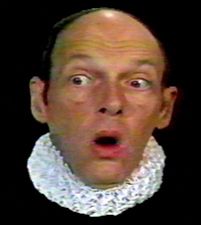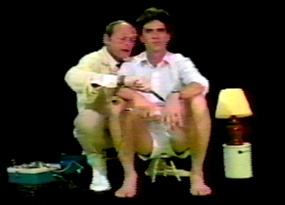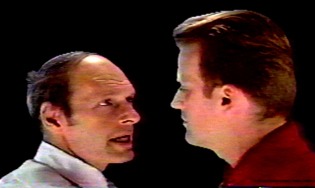Jerry Hunt's Four Video Translations
by Michael Schell
NOTE: These are the liner notes to Four
Video Translations, a videotape available from oodiscs (see Jerry
Hunt: recorded works). The tape includes Birome [zone]: plane (fixture),
Bitom (fixture): topogram, Talk (slice): duplex and Transform
(stream): core. These notes were written in 1994.
 American
music has a tradition of visionary composers, mystics who carved a unique art
from an intensely personal world view. Ives, Varèse, Partch and Sun Ra all
belong to this tradition. So does Jerry Hunt. Standing outside the musical
mainstream, he is largely unknown to the concert-going public. But to those
familiar with his work, Jerry inspired a devoted, almost fanatical, following.
His collaborations with Karen Finley brought him wider attention, and led to his
role in the NEA "Forbidden Four" scandal during the early 1990s. It is
hoped that the release of these four video translations will bring his
work to a new audience, and serve as a memento for those who knew him in real
life.
American
music has a tradition of visionary composers, mystics who carved a unique art
from an intensely personal world view. Ives, Varèse, Partch and Sun Ra all
belong to this tradition. So does Jerry Hunt. Standing outside the musical
mainstream, he is largely unknown to the concert-going public. But to those
familiar with his work, Jerry inspired a devoted, almost fanatical, following.
His collaborations with Karen Finley brought him wider attention, and led to his
role in the NEA "Forbidden Four" scandal during the early 1990s. It is
hoped that the release of these four video translations will bring his
work to a new audience, and serve as a memento for those who knew him in real
life.
Jerry was a Texan. Born in Waco in 1943, he lived his entire life in Texas,
spending most of his later years in a self-built house on his family ranch. As a
child he became interested in mysticism and ceremonial magic, joining the
Rosicrucian order and attaining initiate status. As an adult he repudiated any
religious affiliation, but remained fascinated by the occult. He was
particularly interested in the English alchemists John Dee, Edward Kelley and
Robert Fludd, and also studied Kabbala, Tarot, Goëtic theurgy and non-Western
systems such as voodoo. An accomplished pianist, Jerry mastered several popular
and contemporary styles, giving recitals and accompanying nightclub acts. After
meeting John Cage in the 1960s, he changed his attitude toward the instrument
and began to experiment with extended playing techniques. Jerry was also versed
in electrical engineering and computer programming. He designed, built and
programmed much of his own equipment, and worked as a technical consultant in
the audio and video industry.
Jerry is best known for a series of solo performances, begun in 1978 and
continued until his death in 1993, which featured theatrics and live electronic
music based on "interrelated electronic, mechanic and social sound-sight
interactive transactional systems". A central theme in these performances
was shamanism as a cultural precedent for the agents of modern technology.
Jerry's on-stage theatrics were themselves highly suggestive of ceremonial
practice, featuring stylized movement and gestures, and incorporating a
multitude of small props, often assembled from found objects by his friend David
McManaway. The accompanying music was typically produced by a complex array of
computers, synthesizers and sensors programmed to follow his actions. Jerry's
paradigm exploited the obvious parallels (remote control, incorporeity,
invisible propagation) between the electronic media and the magical world.
![Birome [zone]: plane (fixture)](images/Birome8.jpg) All
this is evident in Birome [zone]: plane (fixture) (pictured at left), a
solo performance piece Jerry "translated" to video. The first thing
that strikes us is Jerry himself: bald, gaunt, wearing his characteristic
unironed white dress shirt, long tie, off-white jacket with unbuttoned cuffs and
loose fitting trousers -- a persona perhaps best described as "central
Texas meat inspector". It is not what you expect from a shaman.
All
this is evident in Birome [zone]: plane (fixture) (pictured at left), a
solo performance piece Jerry "translated" to video. The first thing
that strikes us is Jerry himself: bald, gaunt, wearing his characteristic
unironed white dress shirt, long tie, off-white jacket with unbuttoned cuffs and
loose fitting trousers -- a persona perhaps best described as "central
Texas meat inspector". It is not what you expect from a shaman.
Jerry shakes convulsively, as though possessed. The accompanying music is
also convulsive, a relentless stream of sampled instrument trills with a host of
percussion sounds thrown in. Jerry holds a variety of implements: staffs, magic
wands, flags, talismans, bells and rattles (the latter heard as well as seen).
Additional talismans occasionally enter from outside the frame. Often Jerry
points or gestures with one hand while holding an implement in another. At other
times he blows a horn, cries out or hits himself with a switch, self-flagellant
style. In a live performance Jerry would pace around the stage, chewing
obsessively on smokeless tobacco or gum while performing his ceremony. The humor
here is in the irony of the scenario: the sublime pretensions of the activity
being carried out by an utterly mundane-looking man.
 Transform
(stream): core (pictured at right) offers a more close-up view of
Jerry's magical world. The Elizabethan collar he wears refers to John Dee,
notorious for his experiments in necromancy and angelic conversation. Jerry
seems to be conversing with some spirits on our behalf. His whistling and
guttural sounds are answered by identical sounds from an unseen voice. The sound
track also includes rattles, small bells and the occasional thumping
poltergeist. Jerry's eyes look up, side to side, and back at us. His expression
is alternately curious, engaged, didactic and satisfied.
Transform
(stream): core (pictured at right) offers a more close-up view of
Jerry's magical world. The Elizabethan collar he wears refers to John Dee,
notorious for his experiments in necromancy and angelic conversation. Jerry
seems to be conversing with some spirits on our behalf. His whistling and
guttural sounds are answered by identical sounds from an unseen voice. The sound
track also includes rattles, small bells and the occasional thumping
poltergeist. Jerry's eyes look up, side to side, and back at us. His expression
is alternately curious, engaged, didactic and satisfied.
Bitom (fixture): topogram (pictured below) uses a second performer.
Michael Galbreth is seated, holding a metal grounding plate in one hand. Jerry,
wearing Latex examination gloves, probes him with a device that measures his
skin's electrical conductivity, a technique used in polygraphy to gauge stress.
These measurements control the pitch of an intense, noisy whine that dominates
the soundscape. In a live performance Jerry would have used a host of hand
props, like the ones seen in Birome [zone]: plane (fixture), along with a
video camera and an array of audio equipment. Here he makes do with his probe
and a shrill tin whistle.
 Jerry
described Bitom (fixture): topogram in terms redolent of an exorcism or
healing ritual. The score refers to his and Galbreth's roles as agent and
patient respectively. But other dyads suggest themselves too:
experimenter and subject, interrogator and prisoner, father and son (in a
peculiar rite of passage). Some find the proceedings charged with an unresolved
sexual tension, heightened by the disparity in mood between the two participants
(Jerry constantly active, Galbreth calm and stationary). The exact nature of
their relationship is unclear, their naive expressions belying the ominous
connotations of the event.
Jerry
described Bitom (fixture): topogram in terms redolent of an exorcism or
healing ritual. The score refers to his and Galbreth's roles as agent and
patient respectively. But other dyads suggest themselves too:
experimenter and subject, interrogator and prisoner, father and son (in a
peculiar rite of passage). Some find the proceedings charged with an unresolved
sexual tension, heightened by the disparity in mood between the two participants
(Jerry constantly active, Galbreth calm and stationary). The exact nature of
their relationship is unclear, their naive expressions belying the ominous
connotations of the event.
These three performances, with their nocturnal music and eerie black
backgrounds, seem to happen at night. Marcel Mauss observed that whereas
organized religion is practiced during the day in public, ceremonial magic is
practiced at night in private. Jerry was a magician, not a priest. His
performance embraces a nostalgia for our primal past and for the magical world
that, according to Piaget, we all inhabit as infants.
 Talk
(slice): duplex (pictured at right) is a different kind of piece, not
dealing with ritual at all. A series of autobiographical vignettes is exchanged
between Jerry and Rod Stasick, each man slicing
off the other's speech by hitting wooden claves. The two men often seem engaged
in conversation, but at other times seem impervious to each other. Occasionally
an exquisite corpse is created, one man picking up the other's theme and going
in a new direction. Watching this piece is like overhearing a nearby personal
conversation: fragments are audible but the logical thread is frayed. In its
emphasis on verbal memory and personal frankness, Talk (slice): duplex
reflects the influence of two of Jerry's last collaborators: Annea Lockwood and
Karen Finley.
Talk
(slice): duplex (pictured at right) is a different kind of piece, not
dealing with ritual at all. A series of autobiographical vignettes is exchanged
between Jerry and Rod Stasick, each man slicing
off the other's speech by hitting wooden claves. The two men often seem engaged
in conversation, but at other times seem impervious to each other. Occasionally
an exquisite corpse is created, one man picking up the other's theme and going
in a new direction. Watching this piece is like overhearing a nearby personal
conversation: fragments are audible but the logical thread is frayed. In its
emphasis on verbal memory and personal frankness, Talk (slice): duplex
reflects the influence of two of Jerry's last collaborators: Annea Lockwood and
Karen Finley.
As we say goodbye to Jerry, we acknowledge the ambiguity in his work. Is this
ceremonial music with magical powers of its own, or is it made by the spirits
themselves? In joining ritual with modern technology, is Jerry suggesting that
our high-tech society hasn't really overcome its superstitions? A congenial and
outgoing man by nature, Jerry became evasive when discussing his own work. His
scores and writings were maddeningly cryptic. His titles combine his peculiar
cybermystical jargon with what Kyle Gann calls "a personal geography of
central Texas". Jerry's rhetoric has all the obscurity of the great
alchemical tracts. In the end, mysticism is about mysteries.
Jerry Hunt: the composer, the magician, the man. This videotape is not a
complete portrait, but a remarkable series of snapshots. Like his music --
which never begins or ends, but merely starts and stops -- it provides a
window into the infinite.



Original Material Copyright © 1994 by Michael Schell. HTML Coding
Copyright © 2001–2016 by Michael Schell.
All Rights Reserved.
 American
music has a tradition of visionary composers, mystics who carved a unique art
from an intensely personal world view. Ives, Varèse, Partch and Sun Ra all
belong to this tradition. So does Jerry Hunt. Standing outside the musical
mainstream, he is largely unknown to the concert-going public. But to those
familiar with his work, Jerry inspired a devoted, almost fanatical, following.
His collaborations with Karen Finley brought him wider attention, and led to his
role in the NEA "Forbidden Four" scandal during the early 1990s. It is
hoped that the release of these four video translations will bring his
work to a new audience, and serve as a memento for those who knew him in real
life.
American
music has a tradition of visionary composers, mystics who carved a unique art
from an intensely personal world view. Ives, Varèse, Partch and Sun Ra all
belong to this tradition. So does Jerry Hunt. Standing outside the musical
mainstream, he is largely unknown to the concert-going public. But to those
familiar with his work, Jerry inspired a devoted, almost fanatical, following.
His collaborations with Karen Finley brought him wider attention, and led to his
role in the NEA "Forbidden Four" scandal during the early 1990s. It is
hoped that the release of these four video translations will bring his
work to a new audience, and serve as a memento for those who knew him in real
life.![Birome [zone]: plane (fixture)](images/Birome8.jpg) All
this is evident in Birome [zone]: plane (fixture) (pictured at left), a
solo performance piece Jerry "translated" to video. The first thing
that strikes us is Jerry himself: bald, gaunt, wearing his characteristic
unironed white dress shirt, long tie, off-white jacket with unbuttoned cuffs and
loose fitting trousers -- a persona perhaps best described as "central
Texas meat inspector". It is not what you expect from a shaman.
All
this is evident in Birome [zone]: plane (fixture) (pictured at left), a
solo performance piece Jerry "translated" to video. The first thing
that strikes us is Jerry himself: bald, gaunt, wearing his characteristic
unironed white dress shirt, long tie, off-white jacket with unbuttoned cuffs and
loose fitting trousers -- a persona perhaps best described as "central
Texas meat inspector". It is not what you expect from a shaman.
 Jerry
described Bitom (fixture): topogram in terms redolent of an exorcism or
healing ritual. The score refers to his and Galbreth's roles as agent and
patient respectively. But other dyads suggest themselves too:
experimenter and subject, interrogator and prisoner, father and son (in a
peculiar rite of passage). Some find the proceedings charged with an unresolved
sexual tension, heightened by the disparity in mood between the two participants
(Jerry constantly active, Galbreth calm and stationary). The exact nature of
their relationship is unclear, their naive expressions belying the ominous
connotations of the event.
Jerry
described Bitom (fixture): topogram in terms redolent of an exorcism or
healing ritual. The score refers to his and Galbreth's roles as agent and
patient respectively. But other dyads suggest themselves too:
experimenter and subject, interrogator and prisoner, father and son (in a
peculiar rite of passage). Some find the proceedings charged with an unresolved
sexual tension, heightened by the disparity in mood between the two participants
(Jerry constantly active, Galbreth calm and stationary). The exact nature of
their relationship is unclear, their naive expressions belying the ominous
connotations of the event. Talk
(slice): duplex (pictured at right) is a different kind of piece, not
dealing with ritual at all. A series of autobiographical vignettes is exchanged
between Jerry and
Talk
(slice): duplex (pictured at right) is a different kind of piece, not
dealing with ritual at all. A series of autobiographical vignettes is exchanged
between Jerry and 